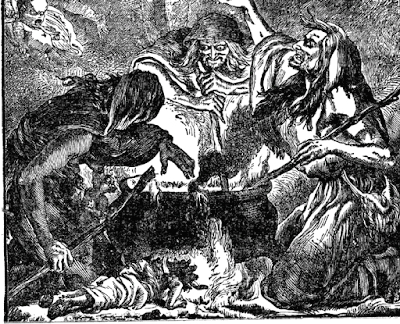The use of spittle by witches for curing warts is quite well known and was and is
used freely in many healing charms , as well as curses.
They believed that spittle contained the essence of their personality, and so by
spitting on a certain area their power and their influence is brought to bear on
that particular spot.
spitting on a certain area their power and their influence is brought to bear on
that particular spot.
Christ cured a man's blindness by spitting into his eyes and it was also common
practice in many ancient religious ceremonies, believing that the saliva of the gods
bestowed healing
practice in many ancient religious ceremonies, believing that the saliva of the gods
bestowed healing
One author of folklore, Ruth St Leger-Gordon recounts a tale from the mid 60's of a
neighbour who was well known to be a witch.
This woman, Mary Ann, cursed a tradesman with whom she had fallen out by spitting
on his doorstep three time and muttering " Take that, take that, take that".
neighbour who was well known to be a witch.
This woman, Mary Ann, cursed a tradesman with whom she had fallen out by spitting
on his doorstep three time and muttering " Take that, take that, take that".
After which the man had nothing bad luck, his wife died, his business failed, he then
went deaf and to cap it all died young.
went deaf and to cap it all died young.
Her powers, it seemed, could be either black or white depending on her mood; for
about the same time she cured a six year old girl of a chronic eye infection which up till
then had the local doctor baffled. Mary Ann drew the young girl to one side and spat
three times into each eye. The mother, a firm believer in Mary Ann's powers forbade
the young girl to wipe the spittle from her face. She was not disappointed for shortly after
the young girls eye complaint cleared up and she was able to attend school again.
about the same time she cured a six year old girl of a chronic eye infection which up till
then had the local doctor baffled. Mary Ann drew the young girl to one side and spat
three times into each eye. The mother, a firm believer in Mary Ann's powers forbade
the young girl to wipe the spittle from her face. She was not disappointed for shortly after
the young girls eye complaint cleared up and she was able to attend school again.
Many people find that they have the gift for using healing charms without having
to be a 'witch' but custom decrees that these gifts must be handed down alternately
from man to woman in each succeeding generation. If there is no one suitable in the
family then the gift is passed on to an outsider.
to be a 'witch' but custom decrees that these gifts must be handed down alternately
from man to woman in each succeeding generation. If there is no one suitable in the
family then the gift is passed on to an outsider.






